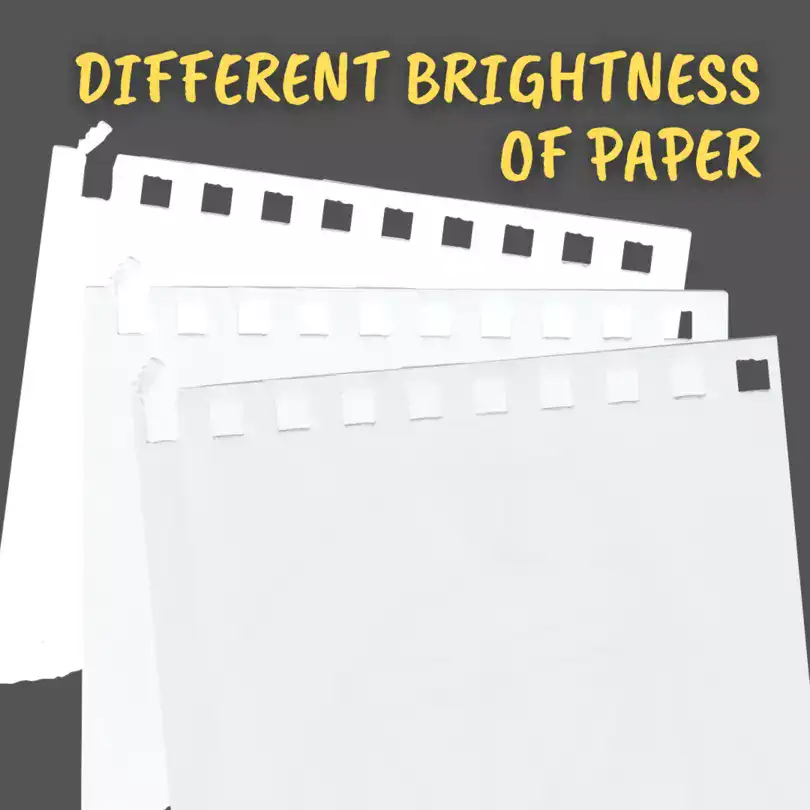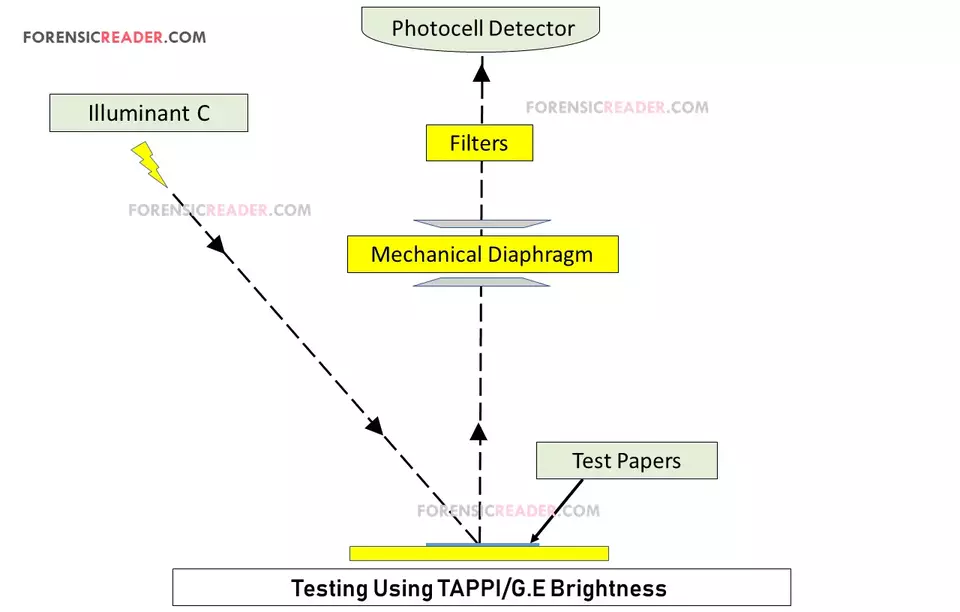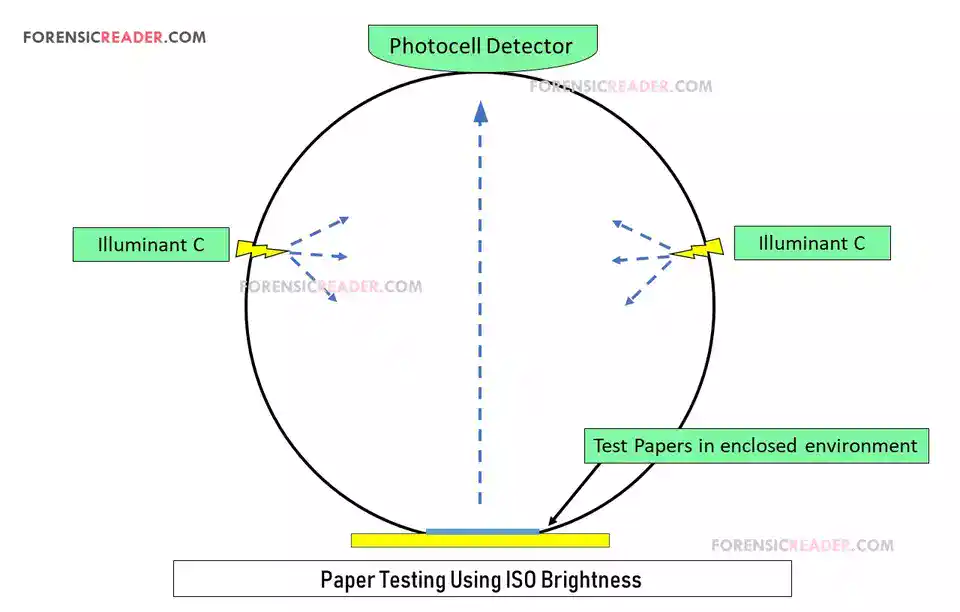Data shows that the human eye can’t distinguish between consecutive brightness values of a paper.
So, how to measure it accurately? How to make it as potent evidence in their paper analysis report?
Therefore, in this post, you’re going to learn more about finding the brightness of paper in terms of TAPPI, ISO, and D65 systems.
- What is the Brightness of Paper?
- What Makes Paper Brighter?
- Forensic Importance of Comparing Brightness of Paper
- How to Choose the Right Bright Paper for You?
- Testing and Measuring Methods For Paper Brightness
- Best Paper Brightness Tester (Also Whiteness Tester)
- Precautions While Using Brightness Test Tools for Forensic Purpose
- General FAQs
What is the Brightness of Paper?

The brightness is defined as the amount of blue light reflected from the paper surface. Thus, a brighter paper reflects more blue light than the dull one.
The blue light reflectance is characteristically measured at a specific wavelength of 457 nm; all other wavelengths are ignored.
What Makes Paper Brighter?
This all starts with the manufacturing process. Manufacturers add Optical Brighteners Agents (OBAs) to make the paper brighter.
They simply trick your eyes by converting invisible UV rays and re-emitting them into visible blue light. These chemicals are often added in papers like bonds, glossy photographic, premium inkjet printed papers, etc.
Technical Info: OBAs absorb light in the UV region (340-370nm) of the spectrum and re-emit light in the violet/blue region (420-470 nm).
Optical Brightening Agents in Paper
There are three main types of optical brightening agents (OBAs) for the paper:
- Diaminostilbene Disulfonic Acid (DAST): Low solubility, hydrophobic, and used to manufacture wet ends.
- Tetrasulfonated OBAs: Average solubility, most common and used for both wet and dry production purposes.
- Hexanesulfonate OBAs: High solubility, premium OBAs, and suitable for dry and coating end of production.
Some other OBAs are Leucophor NS liquid, Leucophor SCA liquid, and Distyryl Biphenyl Derivative (DSBP). [Source]
Forensic Importance of Comparing Brightness of Paper
The reliability of optical observation of paper depends on the perception of the questioned document examiner.
As I already stated, it is hard to differentiate between two brightness levels when they are so close. And brightness level is a critical means in optical observation.
By knowing the brightness level and OBAs, the origin of the papered sheet can be determined. This also increases the chance of finding the relative age of the document.
Therefore by comparing two brightness levels of the paper, the examiner can determine:
- Whether they belong to a ream of sheet (commercial pack of 500 sheets)
- Possible type of paper (inkjet or laser printer paper)
- Distinguish between/among pages
- Possible origin of paper
- Absolute age (if a change in OBAs by manufacturer)
How to Choose the Right Bright Paper for You?

The normal brightness level of the paper is 90 to 100.
If your major work requires grayscale print, try to get a standard bright paper i.e. 92. They are ideal for printing notes, printable assignments, and office work.
If your work demands more vivid colors, say for presentation or display, switching slightly higher to 94 or 96 makes the color more appealing and bright.
And if you want shades similar to those found on novel pages, you’ll need slightly dull sheets with a brightness level of 90. They’re still brighter than the novel ones, but that’s what’s readily available; otherwise, you’ll have to order them in bulk.
My personal consideration, I don’t focus more on paper’s brightness unless you’re setting a photo exhibition.
Because paper manufacturers take all this in consideration, and their result is backed by numerous tests and data.
I know, the data does not replicate all of the user’s requirements, but it is adequate for 99% of you.
Testing and Measuring Methods For Paper Brightness
There are three main systems for measuring brightness and they share different measuring values. These are as follows:
- TAPPI/G.E Brightness
- ISO Brightness
- D65 Brightness
1. TAPPI/G.E Brightness
- TAPPI stands for Technical Association of the Pulp and Paper Industry
- GE because General Electric invented the first paper brightness testing machine.
- They are also called T452
- Used majorly by North American Standards.
Method of Testing Using TAPPI/GE
An arrangement of the illuminator as a light source, and a photocell receptor as the detector is used for finding the brightness value.
- Illuminant: Illuminant C
- Detector: Photocell or diode receptor
- A form of directional brightness tester
The amount of light received by the photocell receptor defines the brightness values with standard 100% reflective magnesium oxide (for comparison).

Procedure:
- A paper sample is placed on the base of T452.
- The illuminating light is placed at 45° to a portion of the paper.
- Photocell receptor is placed right above the paper sheet (perpendicular to the base).
- Intensity of reflected light (blue) is recorded by photocell and compared with reference samples.
Disadvantage:
- Lower value than other testing standard methods as only one angle for finding value.
- May be several reflectance values because of the non-uniformity of the sheet surface.
- Different results for long and short grains of paper.
Quick Note: At manufacturing, due to fluid mechanics, fibers get arranged in the direction of machine run i.e. along the longer axis of a rectangular sheet (called long grain). While short grain is defined as the shorter axis of a rectangular sheet.
2. ISO Brightness
- Based on diffuse optical geometry with multiple angles of illumination.
- Diffuse illumination, 0° observation;
- Also called ISO 2470-1
- Used by European measuring standards
Method of Testing Using ISO Brightness
Two illumination sources and one photocell detector are arranged in a special integrated sphere system.
- Illuminant: Illuminant C
- Detector: Photocell or diode receptor
- Sphere: Highly reflective non-glossy internal walls
- A form of diffuse brightness tester
The received energy at the detector quantifies at 457 nm to give ISO brightness value.

Procedure:
- The paper sample is illuminated by light projected by two lamps.
- Sphered walls even illuminate paper because of inter reflection (diffusively).
- Photodiode reflection is positioned perpendicular to the base i.e. 0°, for recording reflectance.
- Recorded spectrum is observed at a specific energy response of 457 nm.
Advantage:
- More reliability toward surface uniformity and arrangement of grains.
- Higher brightness level than TAPPI/GE
- Compute actual brightness level at 457 nm without any need of a comparative standard brightness object.
3. D65 Brightness
- Same as ISO brightness (2470-1) with different D65 illuminants.
- Also called ISO 2470-2
- Illuminant: CIE (International Commission on Illumination) standard illuminant D65
With the new illuminant D65, a significantly greater amount of UV energy is produced. This results in greater optical brightness response than TAPPI/GE and regular ISO brightness systems.
Best Paper Brightness Tester (Also Whiteness Tester)
If you’re searching for the best paper brightness tester for laboratory and forensic purposes, I have found some of the latest and most sophisticated paper brightness testers that can also determine whiteness for you.
1. L&W Elrepho
Industry-standard paper spectrophotometer, that not only measures the brightness but also color, opacity, and whiteness of paper, paperboard, tissue, pulp, coating inks, and fillers.
- Automatically positioning of paper and lifting sample.
- Easy to operate and calibrate.
- Multiple measuring environments such as D65 illuminant, C illuminant.
- Gets both ISO (diffuse) and TAPPI (0°) based brightness measurements.
- ERIC and INGEDE based residual ink evaluation.
2. TEST/Plus® ISO Brightness
Technidyne’s TEST/Plus product is a simple ISO brightness tester tool. The values are measured to ISO brightness scale from 0-100.
Higher the values, higher is the brightness of the paper. So, let’s say, if a paper has an ISO brightness of 92 while the other is 94, it is harder to differentiate between the two.
But with the TEST/Plus industry-standard ISO Brightness tester, you can easily compare them and easily differentiate between them.
Know more about Test/Plus Iso Brightness
Note: There is also a version of the TEST/Plus tester tool that uses TAPPI-based measurements for computing brightness levels. You can know more about the TEST/Plus TAPPI brightness tester from here.
3. Brightness Tester PCE-WNM 100
If you’re looking for a compact testing tool that can determine the whiteness/brightness (TAPPI) of a paper, then Brightness Tester PCE-WNM 100 is a considerable option.
It fits in hand, and uses a TAPPI-based measuring system i.e. 45/0 measuring geometry, to come up with the values of surface brightness.
However, for more accuracy, you need to take multiple readings for the paper.
Other Paper Brightness Tester are:
- PROFILE/Plus®ISO Brightness Tester
- TEST/Plus® ISO Brightness Tester
- Color Touch® PC ISO Brightness Tester
Precautions While Using Brightness Test Tools for Forensic Purpose
- Use a single optical instrument for all tests.
- Take at least 6 consecutive sample values if paper ream is available. (know more why 6? Just click here and hover to Wire and Felt Marks section—links).
- Try to use diffuse-based methods i.e. ISO brightness instruments because they are widely accepted and more reliable than TAPPI.
- Use thick rubber gloves while handling questioned doucments.
- Try to handle paper from edges and croners.
- If possible, use automatically aligned instruments like L&W Elrepho.
General FAQs
What is the difference between 92 vs 96 brightness?
Higher the value to the brightness scale, the brighter the sheet. So, a sheet with a brightness of 96 is brighter than 92. The difference might be not visible for someone for that you can use a brightness tester.
Is 92 bright paper good?
Yes, it is the most popular paper for both inkjet and laser printers. They are not so bright that they prink in the eyes, nor dull enough that you can’t see greyscale print in ambient light. Plus, ISO brightness 92 is the most commonly encountered paper from a forensic point of view.
Reference:
- Shades and Whiteness of Paper (Source)
- Optical Brightener by Sciencedirect (Source)
- Understanding Paper Brightness by Sappi Techincal Service (Source)
- Paper Brightness, Whiteness & Shade: Definitions and Differences (Source)
Continue Reading:
- 21+ Forensic Questioned Document Instruments And Tools With Uses
- Can a Watermark on Paper be Forged? Prevention and Detection
- Identification of Paper Additives: Fillers, Oil, Waxes, and Pigment
- Forensic Watermark Examination of Paper: Destructive And Non Destructive Analysis

FR Author Group at ForensicReader is a team of Forensic experts and scholars having B.Sc, M.Sc, or Doctorate( Ph.D.) degrees in Forensic Science. We published on topics on fingerprints, questioned documents, forensic medicine, toxicology, physical evidence, and related case studies. Know More.
